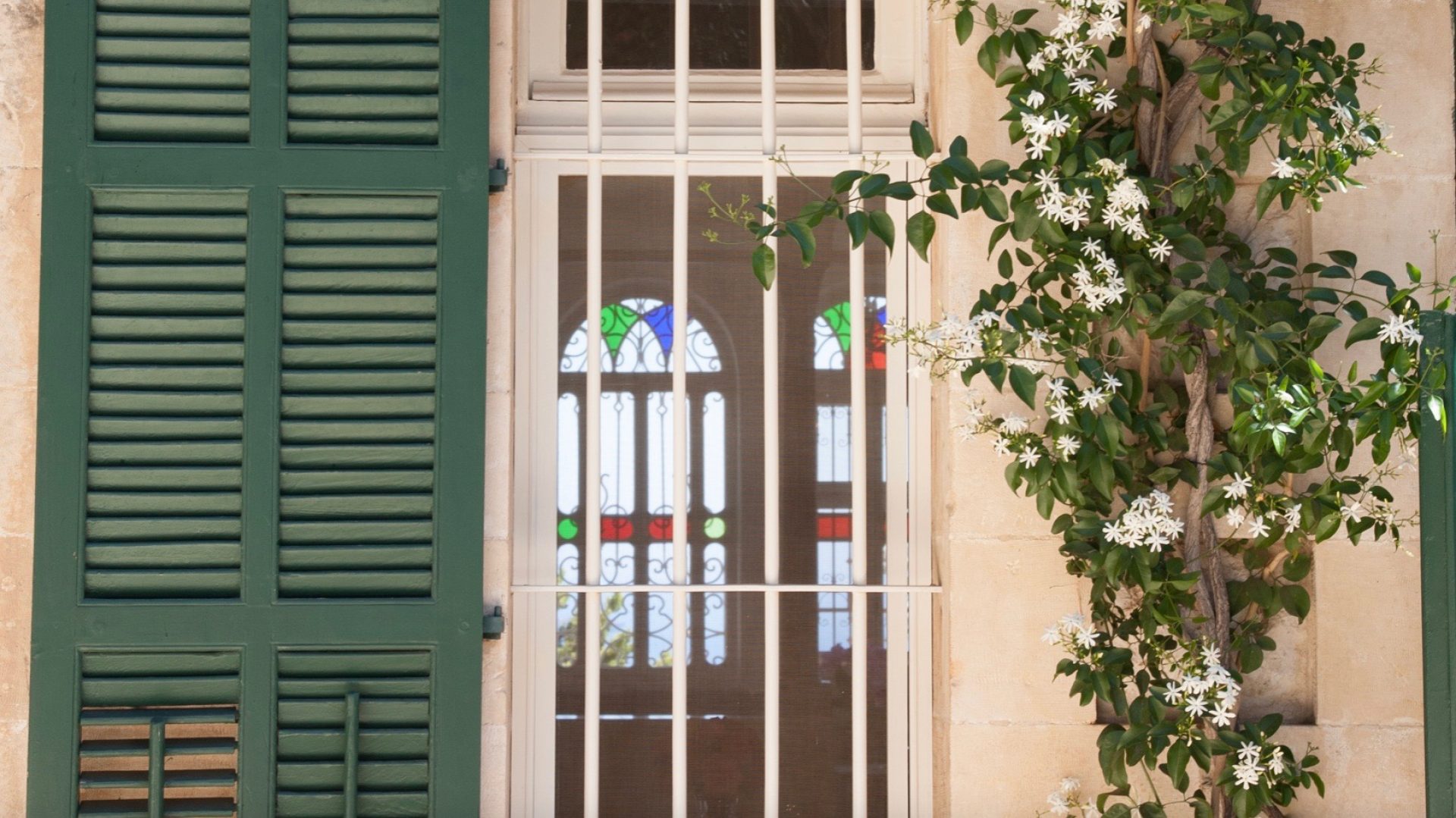The journey of 'Abdu'l-Baha's Tablet to The Hague

‘Abdu’l-Bahá
A photo chronology — In December 1919 ‘Abdu’l-Bahá wrote His Letter to the Central Organization for a Durable Peace. In this comprehensive letter He offered the Bahá’í vision on achieving and preserving universal peace. Since the secretary’s office of this peace organization was located in The Hague, the Netherlands, this letter became known as the Tablet to The Hague. — Instead of the word ‘letter’, Bahá’ís often prefer the word ‘tablet’ to emphasize the authority and durability of the text by referring to a flat stone with inscriptions. — The two Persian couriers who delivered the letter to the Netherlands used the name Tablet of Peace (Lawh-i-Sulh).
Ten years ago (2009) Mr. ‘Alí Nakhjavání, former member of the Universal House of Justice, suggested that the circumstances of ‘Abdu’l-Bahá’s Tablet to The Hague should be investigated and recorded. The National Spiritual Assembly of the Bahá’ís of the Netherlands thereupon requested Dr. Jelle de Vries, author of the book The Babi Question You Mentioned … The origins of the Bahá’í Community in the Netherlands, 1844-1962, to prepare a detailed chronology of the events related to the delivery of the tablet.
Now, at the occasion of the 100th anniversary of ‘Abdu’l-Bahá’s letter, and because of its connection with the Netherlands, its enduring importance and international character, this Dutch website has launched a special page for international visitors. (Deze pagina is ook beschikbaar in het Nederlands) We hope that you will enjoy this photo chronology, and that it will give you context when studying the actual content of ‘Abdu’l-Bahá’s letter.
Bahaigeschiedenis.nl - an initiative of Jelle & Adib - 2019
The official website of the International Bahá’í Community is: bahai.org
***
Peace by Justice
It has never been tried before - an international government-level conference on world peace. At the initiative of Tsar Nicholas II of Russia, delegates from 26 mainly European countries, but also from the United States, Mexico, China, Japan, Siam (Thailand) and Persia (Iran) meet in The Hague, the Netherlands, in 1899. A second conference follows eight years later. This time there are delegates from 45 of the then 57 sovereign states. Although the concrete results of both peace conferences are poor, preparations for a third peace conference in The Hague will begin in early 1914.
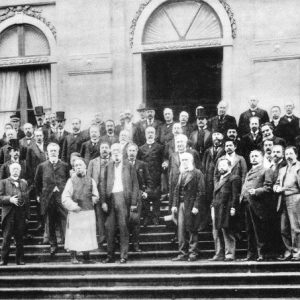
1899 May 18 - July 30 — After two months of discussions behind closed doors, the most important result of the international peace conference in The Hague is the establishment of an International Court of Arbitration to which countries can submit their mutual disputes, without starting a war - ‘Peace by Justice’. (photo: delegates at Huis ten Bosch palace in The Hague)
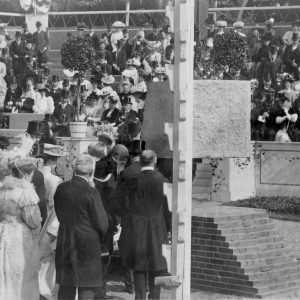
1907 July 30 — During the second international peace conference in The Hague, the foundation stone is laid for the seat of the International Court of Arbitration. The funds for this ambitious building project have been made available by the richest man on earth, the retired American steel magnate turned philanthropist Andrew Carnegie.
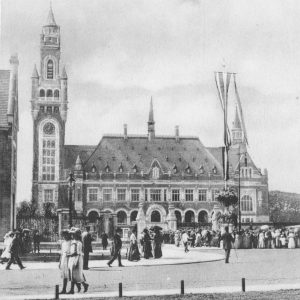
1913 August 28 — Queen Wilhelmina and Andrew Carnegie open in The Hague the new seat for the International Court of Arbitration - the Peace Palace. The building will become a landmark of the city. A third international peace conference is scheduled for 1916.
'Abdu'l-Baha's journey across North America

1912 April 11 - December 5 — Peace was also the main goal of ‘Abdu’l-Bahá’s journey across North America. When Bahá’ís afterwards wanted to publish a compilation of His estimated 400 speeches, and asked Him for an appropriate title, He answered them: ‘Name the book The Promulgation of Universal Peace’. (photo: ‘Abdu’l-Bahá at the 18th annual Lake Mohonk Conference on International Arbitration, 14 May 1912)
“As to you: Your efforts must be lofty. Exert yourselves with heart and soul so that, perchance, through your efforts the light of universal peace may shine and this darkness of estrangement and enmity may be dispelled from amongst men, that all men may become as one family and consort together in love and kindness, that the East may assist the West and the West give help to the East, for all are the inhabitants of one planet, the people of one original native land and the flocks of one Shepherd.”
— ‘Abdu’l-Bahá on board the Celtic, on the day the ship set sail, New York 5 December 1912
a storehouse of explosives

1914 June 28 — In His American speeches ‘Abdu’l-Bahá had repeatedly warned against the arms race in Europe: ‘Europe is a storehouse of explosives awaiting a spark.’ The murder of the Austrian successor to the throne and his wife by a student in Sarajevo (Bosnia), turns out to be that spark. A mere five weeks later Austria-Hungary, Germany and Turkey are at war with Serbia, Russia, France, Britain, Italy and Belgium. Peace activists all over the world are in shock. (photo: Archduke Franz-Ferdinand and his wife Sophie on the day of their assassination)
“Pitch-black the year 1914 suddenly appears before the friends of peace. The clock has been set back with a brisk movement, full of harsh violence.”
— Dutch parliamentarian Frits Knobel, 23 September 1914
Dutch Anti-War Council
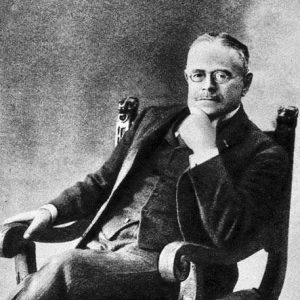
1914 October 8 — In The Hague the ‘friend of peace’ and Member of Parliament Frits Knobel, establishes the Dutch Anti-War Council (Nederlandsche Anti-Oorlog Raad). It is an attempt to unite the numerous, but divided, Dutch peace activists under a kind of umbrella organization. The initiative is a success. Within two months the Council has a membership of 3.500. However, not a month passes before Knobel has to resign as chairman. His German wife has, along with other ladies, placed a call for financial support for the German Red Cross in the newspapers. Since the Council seeks international cooperation with peace activists of all warring parties, neutrality is considered essential. This resignation not only robs the Council of an experienced diplomate, but also of someone who knows the Bahá’ís. Knobel had been Dutch Consul-General in Persia (Iran) and had in the 1890s, during persecutions of Bahá’ís in Isfahan and Yazd, personally stood up for them with the Persian government. — Knobel’s successor is another parliamentarian, Henri Dresselhuys. (photo: chairman Knobel 1914)
Central Organization for a Durable Peace
The Dutch Anti-War Council organizes a small international conference in Hotel Wittebrug in The Hague to discuss the fundamentals for a lasting peace, once the war is over.
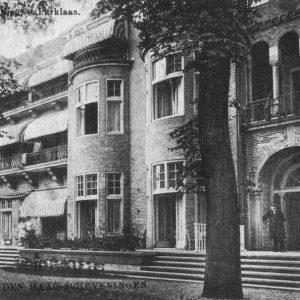
1915 April 7-10 — When chairman Dresselhuys opens the meeting, 30 delegates from 10 European counties and the United States attend. Agreement is reached on the establishment of a Central Organization for a Durable Peace. Its primary aim is not to end the current war, but to prevent future wars. The secretary’s office of the new organization will coincide with that of the Dutch Anti-War Council in The Hague. (photo: Hotel Wittebrug 1912)

1915 May - July — The Central Organization, the only international organization of peace activists during the war, sends its Manifesto & Minimal Program to sympathizers and newspapers all over the world. It is looking for peace specialists (not politicians) who could represent their country at a future third international peace conference in The Hague. Ahmad Yazdání and ‘Alí-Muhammad Ibn-i-Asdaq, two Bahá’ís in Tehran (Persia), draw the Organization’s attention to ‘Abdu’l-Bahá.
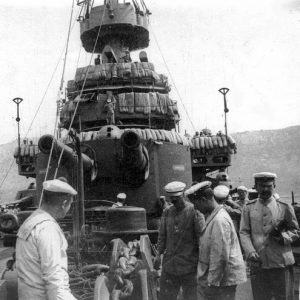
1915 — The Ottoman Empire, which included the Levant, takes sides with Austria-Hungary and Germany. To protect the Suez Canal, the British and French impose a naval blockade in the Mediterranean Sea. Communication and travel in and out of the region become almost impossible. (photo: the armoured cruiser Jeanne d’Arc)
“The guarantee of a lasting peace and the laying of new foundations for world politics affects all humanity. That is why, following the peace negotiations, which more particularly concern the warring states, a World Congress, the ‘Third Hague Peace Conference’, must meet. But more must be done. The time has now come for the peoples to have a say too. Foreign policy should no longer be the exclusive domain of a small circle of professional diplomats, a system that now ended in complete failure. New ground have to be broken; new forces must be called to the rescue.”
— Quote from the Manifesto of the Central Organization for a Durable Peace, 1915
a letter to 'Abdu'l-Baha
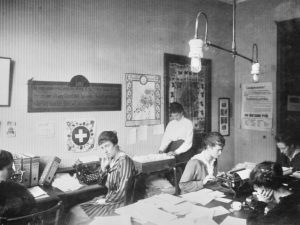
1916 February 11 — After a correspondence with Yazdání and his friends, the Central Organization sends a letter to Tehran to be handed over to ‘Abdu’l-Bahá. But because of the war, Haifa cannot be reached. (photo: the secretary’s office of the Central Organization for a Durable Peace, Theresiastraat 51, The Hague 1916)
Peace Treaty of Versailles
1919 January 18 — Food prices are sky-high, and there is not a single (hotel) room to be found in Paris, when hundreds of diplomats and their staff from 27 different countries start their peace talks in various meetings. The ‘Big Four’ leaders (Britain, France, Italy and the United States) dominate the negotiations.

1918 September 28 — British forces advance from Egypt into Palestine and by the time Haifa is taken, the war in the Middle East is drawing to an end. On October 4th the Bahá’ís in America and Europe are informed that ‘Abdu’l-Bahá is ‘well and protected’. In November an armistice is also signed at the European front. During the ‘Great War’ an estimated 16 million people lost their lives. (photo: British-Indian cavalry in Haifa)
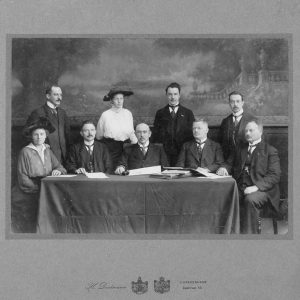
1919 January 7 — Now that the war is over and peace negotiations are about to start in Paris, the Dutch Anti-War Council disbands itself. Its secretariat in The Hague however continues to serve the Central Organization for a Durable Peace and is now called the Executive Committee. (photo: board of the Dutch Anti-War Council, 1916)
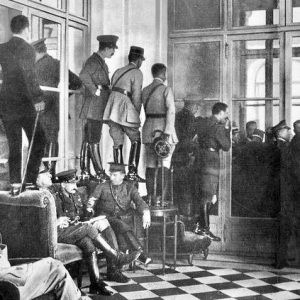
1919 June 28 — The Peace Treaty is signed in the Hall of Mirrors of the Palace of Versailles, near Paris. The conditions for peace are imposed by Britain, France and the United States. Neither the defeated parties nor the more than 200 peace specialists from 39 countries of the Central Organization have been involved. The treaty is not a compromis, but a dictate - the seed of a new war.
“Universal Peace will not be brought about through human power and shall not shine in full splendour unless this weighty and important matter will be realized through the Word of God.”
— ‘Abdu’l-Bahá to George D. Buchanan (and President Woodrow Wilson), letter 10 January 1919
Tablet of Peace

1919 December 17 — With a delay of three years the letter from the Central Organization for a Durable Peace reaches ‘Abdu’l-Bahá in Haifa. Immediately an answer is written and translated: the Tablet of Peace. Ahmad Yazdání and ‘Alí-Muhammad Ibn-i-Asdaq are asked to deliver this extensive letter in person. — Yazdání says goodbye to his wife and children in Tehran and starts his journey to Haifa. Meanwhile the Netherlands reluctantly - for the obligation to take collective action against aggressors is contrary to its policy of neutrality - joins the League of Nations (March 1920). This new international organization was founded as part of the Versailles Peace Treaty. (photo: ‘Abdu’l-Bahá and friends in Haifa, winter 1919)
“O ye esteemed ones who are pioneers among the well-wishers of the world of humanity! — The letters which ye sent during the war were not received, but a letter dated February 11th, 1916, has just come to hand, and immediately an answer is being written. Your intention deserves a thousand praises, because you are serving the world of humanity, and this is conducive to the happiness and welfare of all. [...]”
— ‘Abdu’l-Bahá to the Central Organization for a Durable Peace, letter 17 December 1919
Haifa
‘Abdu’l-Bahá had accompanied Bahá’u’lláh in His banishment to the Holy Land in 1868. After He was formally released from captivity (1908), had entrusted the remains of the Báb to a simple mausoleum on the slope of Mount Carmel (1909), and had moved from Akka to Haifa (1910), that small town at the Mediterranean Sea became the center of the Bahá’í world.

1920 April — After a journey from Tehran over the Caspian Sea to Baku, over the Caucasus and the Black Sea to Istanbul, and over the Meditarranean Sea to Jaffa, Yazdání finally arrives in Haifa. The journey had taken 40 days. (photo: Haifa train station)
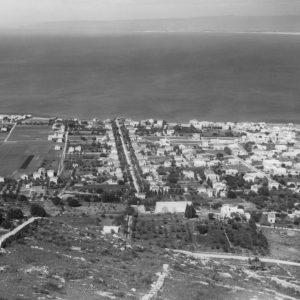
His friend Ibn-i-Asdaq is already a few months in Haifa. It was probably he who brought the letter of the Central Organization from Tehran to ‘Abdu’l-Bahá. (photo: Haifa 1918)
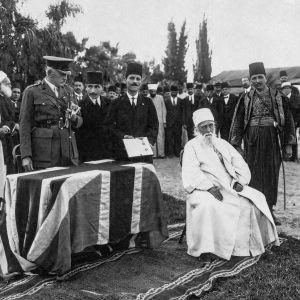
1920 April 27 — Yazdání stays a month in Haifa. He is there when ‘Abdu’l-Bahá receives a knighthood of the British Empire.
From Haifa to Port Said
1920 early May — After a stay ‘at the Holy Threshold’, Ahmad Yazdání and ‘Alí-Muhammad Ibn-i-Asdaq start their journey to the Netherlands.
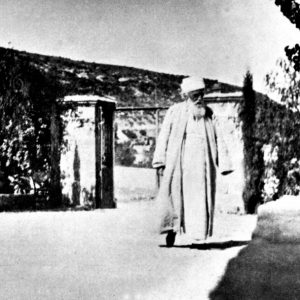
In the afternoon before their departure, ‘Abdu’l-Bahá takes a walk along the German street (Ben Gurion Avenue) with His two delegates, giving them some last instructions.
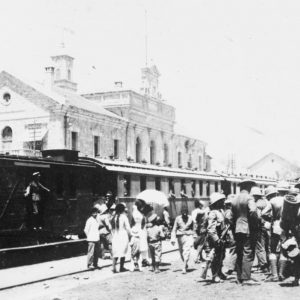
Early May Yazdání and Ibn-i-Asdaq travel from Haifa (photo) to Cairo by train of the Palestine Military Railway. The facilities are basic and the journey takes around 10 hours.

They cross the Suez Canal via the new railway swing bridge at Kantara.

To obtain a visa for the Netherlands, the two delegates go from Cairo’s main railway station (photo) to the villa of the Dutch Ambassador on the island of Gezireh in the Nile. Mahmud Nushugati, a Bahá’í of Port Said, is their guide and interpreter.
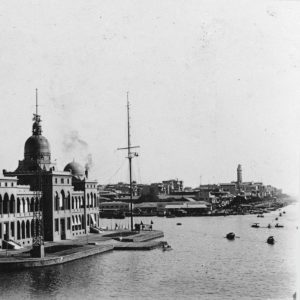
Port Said was founded in 1859 for the construction of the Suez Canal. The city lives off international shipping. Every week its harbour is also visited by several ships from the Netherlands and the Dutch East Indies (Indonesia).
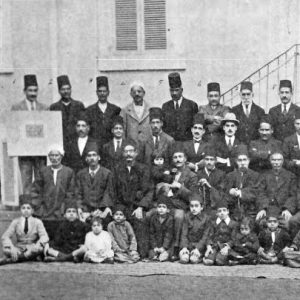
The city has around 100.000 inhabitants, including many foreigners. Just like in Cairo, Alexandria and Ismailia there is a small local Bahá’í community. (photo 1925)
“He said: If you have to speak, do not think in advance ‘What should I say?’, but focus your attention on the Abhá Kingdom for a few moments. You will get inspiration like the one I got in America where I spoke at important meetings. After focusing my attention on the Abhá Kingdom for a few moments, I saw heavenly support going through the public like a wave.”
— Ahmad Yazdání quoting one of ‘Abdu’l-Bahá’s instructions
Mailboat Tambora
1920 May 11 — In Port Said, Yazdání and Ibn-i-Adaq intend to take the first Dutch ship bound for Rotterdam, the mailboat Tambora.
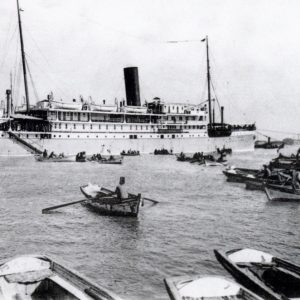
The steamer is already fully booked with passengers who had boarded in Batavia (Jakarta), in the Dutch East Indies (Indonesia). (photo: Tambora in Port Said)
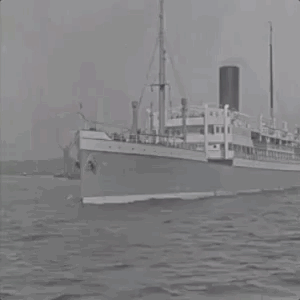

They are assigned to a place in the Javanese servants quarters (Javanen verblijf); a room for 24 persons, with wooden bunk beds, lacking a view or fresh air - not a very comfortable place for the then 70-year-old Ibn-i-Asdaq.
From Port Said to Rotterdam
Port Said

The Tambora arrives in Port Said on May 11, takes in coal, food and mail, and leaves for Rotterdam that same day in the late afternoon.
Tambora
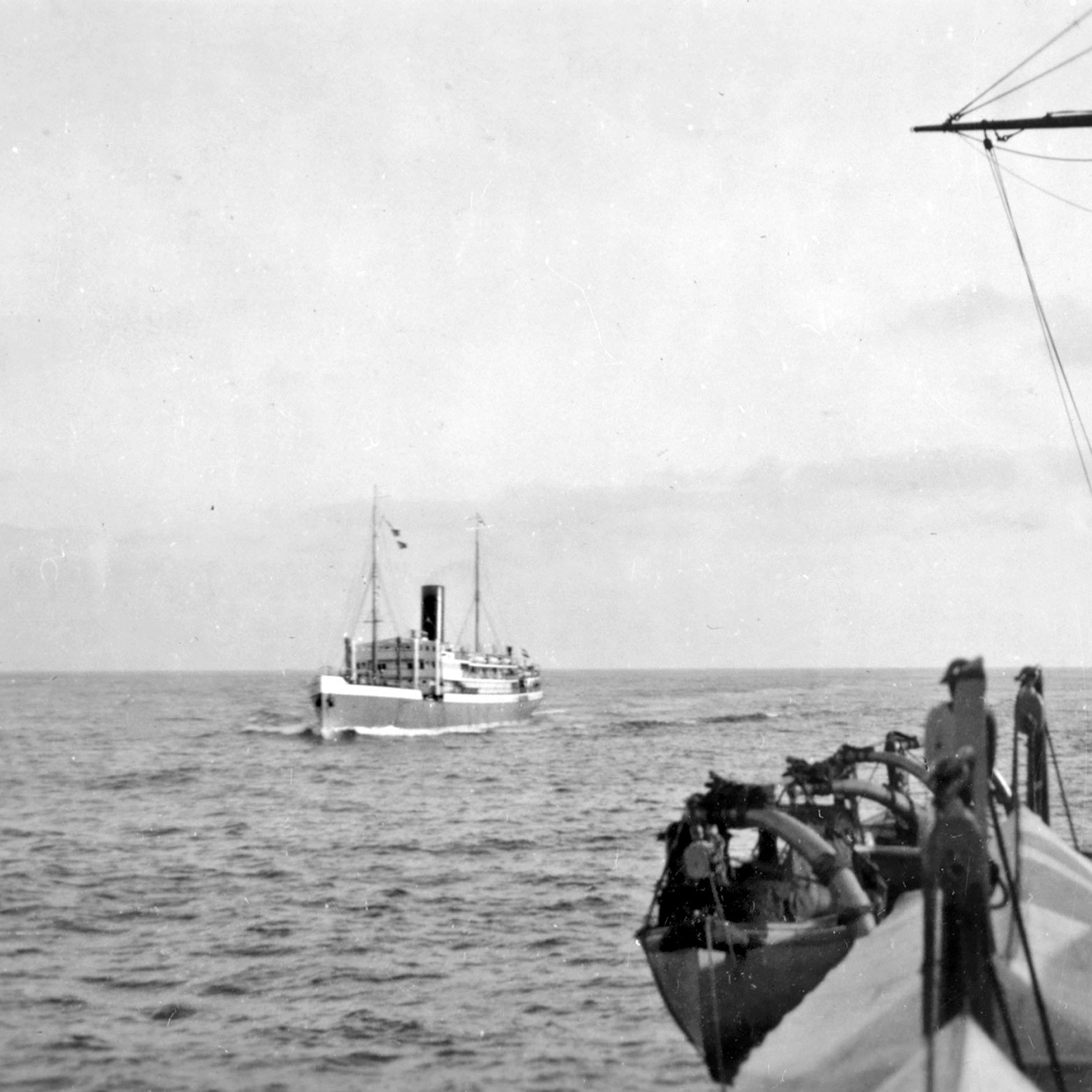
The passenger-cargo vessel Tambora was put into service in 1910. The ship has a length of 125 meters and a width of 15 meters.
Crew
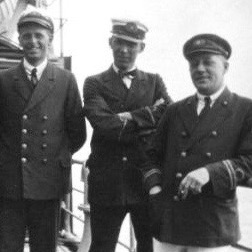
A crew of about 90, including sailors, stokers, machinists, oil men, cooks, carpenters, servants, a barber, a doctor ... take care of more than 200 passengers.
Marseille
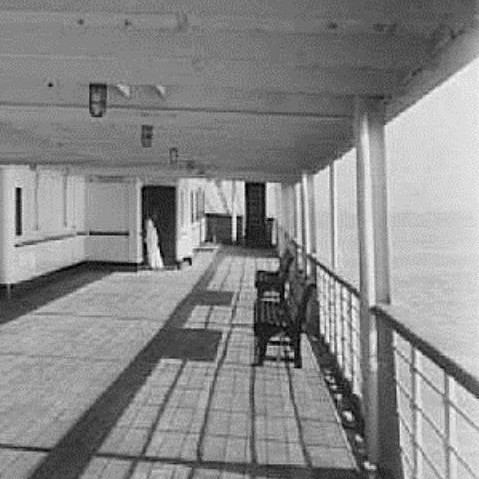
The Tambora is overbooked with passengers who boarded in Batavia (Jakarta). The French port city of Marseille is therefore being skipped.
Gibraltar

On May 18, at 4 o'clock in the morning, the Tambora passes the Strait of Gibraltar.
Atlantic Ocean
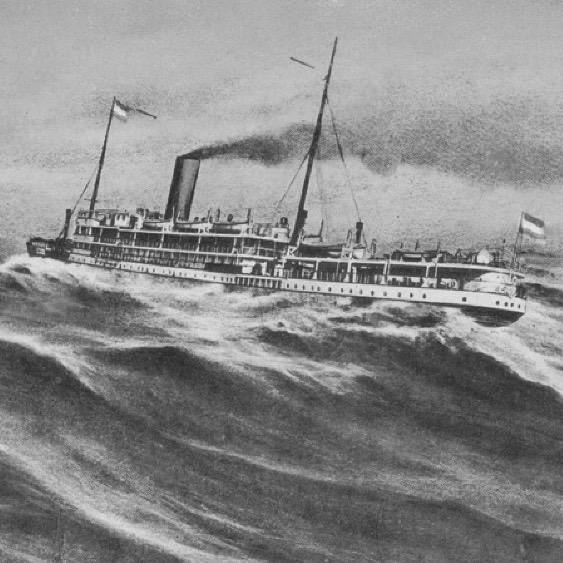
The Tambora is specially fitted for the tropics. It is fully electrically lit, with electric fans in all cabins, and special cold rooms for goods.
Rotterdam

The Tambora turns onto the waterway that connects the North Sea with the port of Rotterdam.
Rotterdam
1920 May 22 — After a sea journey of 11 days the Tambora arrives at the port of Rotterdam, one of the largest ports in the world.
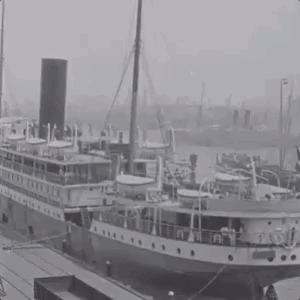
With the help of tugboats, the steamer is moored on the quay of the Rotterdamsche Lloyd shipping company. (film: stern of the Tambora)

It is half past two in the afternoon. The sky is clear, there is a gentle breeze from the west, and it is 13ºC. (photo: aerial view of the Lloydkade in Rotterdam)
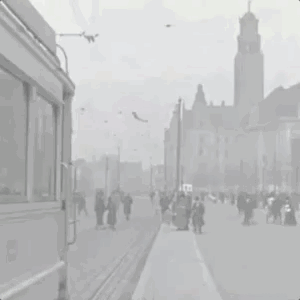
Ahmad Yazdání and ‘Alí-Muhammad Ibn-i-Asdaq travel by tram to one of the four railway stations in Rotterdam, most likely Delftsche Poort station. (film: tram on the Coolsingel in Rotterdam)
“Mr. Ibn-i-Asdaq wore a turban and a matching long cloak, and I was dressed in European style Iranian clothing and hat. That is how we went from Rotterdam to The Hague. The people were surprised to see us. They did not know from which country we came. Some assumed we were Turks. Later in a city in the Netherlands people and children gathered around us; smiling and mocking. At that time the police sent the crowd away.”
— Ahmad Yazdání, recollections
The Hague
1920 May 22 — The secretary’s office of the Central Organization for a Durable Peace is located in The Hague. The city is in the west of the Netherlands, has a population of 355.000 (1920), and is the seat of the Dutch Government.
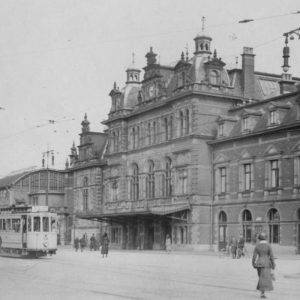
Yazdání and Ibn-i-Asdaq arrive in The Hague at the Hollandsch Spoor railway station.
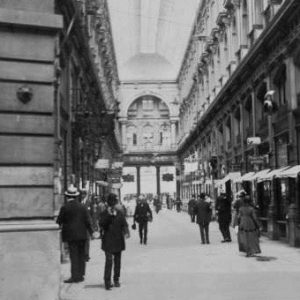
The Passage is a famous glass covered shopping arcade in the centre of The Hague.
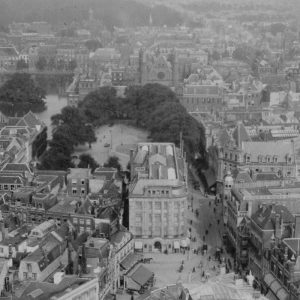
The complex of buildings behind the trees of the Buitenhof square houses the Dutch Parliament; in front the Maison de Bonneterie fashion house.
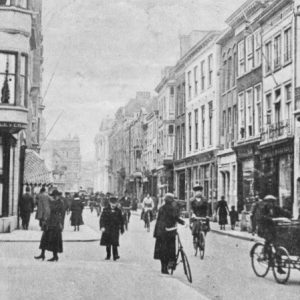
The Noordeinde is the city’s main shopping street.


Yazdání and Ibn-i-Asdaq take a room at Hotel De Zalm in the city center near Paleis Noordeinde, the residence of the royal family.
“In the hotel I immediately noticed two Easterners: a friendly sympathetic young man with the well known Persian fez on his head, and an old man with a turban and a long cloak, who moved through the corridors with stately slowness. [...] The latter Persian, the old one with the turban, spoke only Persian and therefore only answered with friendly bows, smiles and unintelligible sounds. But the young one, Yazdání, also speaks French and Esperanto and easily lend himself to an interview.”
— Jan van der Lans in De Tijd, 17 July 1920
The Delivery of the Tablet of Peace
1920 May 27 — After the Pentecost holiday ‘Abdu’l-Bahá’s Tablet of Peace is delivered into the hands of the Executive Committee of the Central Organization for a Durable Peace at its secretary’s office in The Hague.
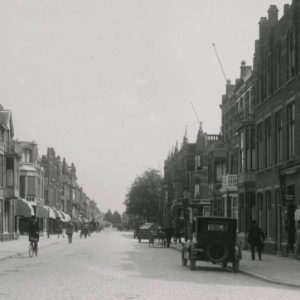
The secretariat of the Central Organization for a Durable Peace is located in the home of its secretary, at Theresiastraat 51, next to a photo studio. A car is parked in front of the house.
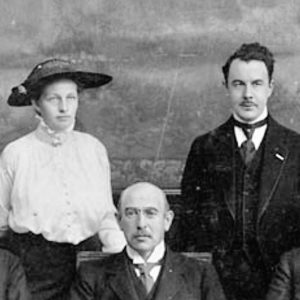
The Executive Committee of the Central Organization consists of (from left to right) secretary Clasien Kluyver, chairman Henri Dresselhuys, and vice-chairman Henri van der Mandere. They are the persons who receive ‘Abdu’l-Bahá’s letter.
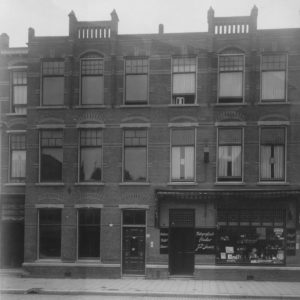
The meeting is somewhat disappointing. The two delegates learn that the Central Organization has been all but dissolved, and that its main objective, a third international peace conference in The Hague, has been surpassed by the establishment of the League of Nations in Geneva.
“It then also became clear that the board met less frequently and that its interest in the subject of durable peace had disappeared. Because the war had ended and a peace had been concluded, they had not considered the necessity of taking further measures. […] Their thinking on the path of universal peace was largely limited to appearance and politics.”
— Ahmad Yazdání, recollections
“Grieve not over the apathy and coldness of the The Hague meeting. Put your trust in God. […] Thou hast now sown the seed. Assuredly it will grow. Its growth dependeth upon God.”
— ‘Abdu’l-Bahá to Ahmad Yazdání, letter 17 July 1920
Presenting the Baha'i ideals
1920 May 27 - June 12 — Now that the main objective of their journey has been met, Yazdání and Ibn-i-Asdaq shift their focus to the proclamation of the Bahá’í ideals in the Netherlands. Already the next day, May 28, the first news item about the delegates is published: ‘The Persian Ahmad Yazdání has come to The Hague to proclaim Bahaism’.
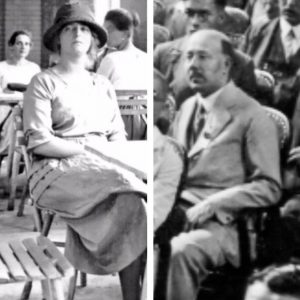
1920 May 27 — During the visit, the Executive Committee learns that Yazdání not only speaks French but also Esperanto. A meeting is arranged with Jan Isbrücker, chairman of the Dutch Society of Esperantists ‘The Future is Ours’ (Nederlandsche Esperantisten-Vereniging ‘La Estonto Estas Nia’), who happens to live in The Hague. Jan Isbrücker’s wife Julia will be Yazdání’s main guide and Esperanto interpreter for the coming weeks. (photos: Julia and Jan Isbrücker, resp. 1923 and 1929)
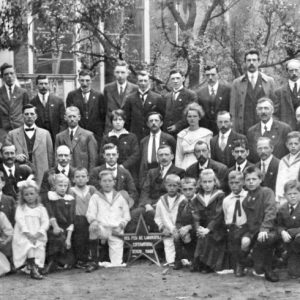
While the Executive Committee is formulating its answer to ‘Abdu’l-Bahá’s Tablet of Peace, Yazdání speaks at several Esperanto meetings at the home of the Isbrücker family, as well as at a large meeting of the Dutch Federation of Workers-Esperantists (Nederlandsche Federatie van Arbeiders-Esperantisten). (photo: 1919)
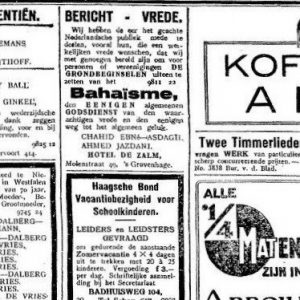
In the week of Monday June 7, Yazdání together with Julia Isbrücker visit the editors of the national newspaper Het Vaderland to offer a press release. It is published in full on the front page of the evening edition of Saturday June 12, under the title: ‘The Only Road to Peace’, and followed by several small announcements.
“Because there were no other Bahá’ís in the Netherlands, except Mr. Enzlin who became aware of our trip later on and invited us to Blaricum, associating and communicating with Esperantists became a tool for teaching the Cause of God.”
— Ahmad Yazdání, recollections
“Mr Yazdání, a sympathetic young Persian, is currently in The Hague where he already gave several Esperanto speeches in private circles about the points of his religious belief. The reports of these are full of enthusiasm, both with regard to the teachings as well as the speeches in Esperanto.”
— Jacob Bruijn in Nederland-Esperanto, June 1920
answer of the Executive Committee
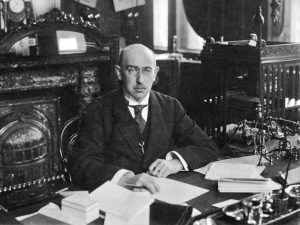
1920 June 12-13 — This weekend the written answer of the Executive Committee is delivered at Hotel De Zalm. Yazdání makes a translation and sends it, together with an accompanying letter of his own, on Monday to ‘Abdu’l-Bahá. (photo: chairman Henri Dresselhuys)
“We consider it a great privilege that You, as the Grand Master of an international movement with followers in all parts of the world, attach such importance to our organization that two of Your disciples have made the long journey to our country to present us a message from You. […]
We will not fail to bring Your message to the knowledge of the members of our Committee abroad. […]
Our cause ‘Universal Peace’ is one of the twelve principles recognized by all the Bahá’ís. On the other hand, these twelve Bahá’í principles do not form part of our program. The pacifism that we represent does not deal with the other points of Your program. The opinions among the pacifists are divided on the subject of religious and political issues. Under these circumstances, it goes without saying that we, as pacifists, cannot give any support to Bahá’ísm, whereas, without being too egotistical, we can call on Your active and assiduous collaboration for the cause of world peace. — Therefore, we would be happy if You or Your representatives would be so kind as to tell us what You propose to undertake in favour of world peace. […]”
— Henri Dresselhuys to ‘Abdu’l-Bahá, letter 12 June 1920
first public speech
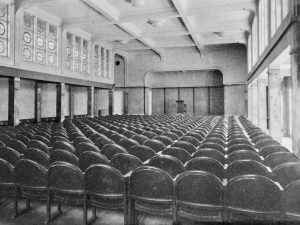
1920 June 22 — At the invitation of Theosophists, Yazdání gives his first public speech at their large new building in The Hague. Jan Isbrücker is Yazdání’s Esperanto interpreter that Tuesday evening. Afterwards, interested parties can choose from three different Dutch Bahá’í pamphlets, all printed by the Theosophical Publishing Company in Amsterdam.
“Finally, the speaker read some lines of Bahá’u’lláh in Persian, in a kind of recitative that was very similar to that of a litany. After these lines had first been translated into Esperanto and then into Dutch, the speaker ended his speech with the assurance that he is ready day and night to provide clarification and information to those who ask for it.”
— De Telegraaf, 23 June 1920
private and public meetings
1920 June 23 - August 1 — The next five weeks Yazdání (with the assistance of his Esperanto interpreters) speaks about the Bahá’í history and principles at various private and public meetings in The Hague, Rotterdam, Haarlem, Laren, Aalsmeer and Zaandam. Several newspapers, both local and national, report on ‘Bahaism’.
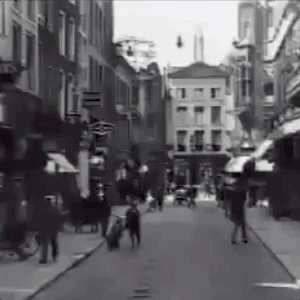
June 24-25 — The Esperanto Workers Club ‘The Hope’ (Laborista Klubo ‘L’Espero’) of Rotterdam organizes two lectures, a private one at their center and the other a public one in the most luxurious hotel of the city: Grand Hotel Coomans. (film: Hoofdsteeg with the facade of Coomans on the right)

June 27 — Together with Julia’s sister and brother-in-law, Catharina and Daniël Roskes, Yazdání takes the train to Haarlem. There, on the grounds of the water tower in the dunes of nearby Overveen, he speaks during an open-air meeting of the Pure Life Movement (Rein Leven Beweging).

June 28 — The only two Dutch Bahá’ís at that time, George and Anna Enzlin from the village of Blaricum, provide Yazdání with the opportunity to give a public lecture at the town hall of nearby Laren.
“Then a special guest was given the floor; special because of his birth, culture and the language in which he spoke. It was a brother from the Far East, Persia, and his name was Ahmad Yazdání, who came to these Low Countries to testify of his new religion, Bahaism. And he spoke in the world auxiliary language, Esperanto. Many of these language experts had come to Overveen to hear him and talk with him. Certainly this was very pleasant for the sympathetic man, who was unable to exchange ideas with the Dutch in his native language. He spoke, and Mrs. Roskes was a very worthy interpreter to him, about the sad conditions that the women in his country suffer from [...] and he praised us, western women, who could go through life so freely and independently. […]
It will not surprise our Persian when we express our sympathy with his teachings, while we regret that we cannot do this fully in his own language. Let us hope that Ahmad Yazdání felt on our ‘field day’, even without words, that we had found a brother in him.”
— Truus van Mierop in Levenskracht, July 1920
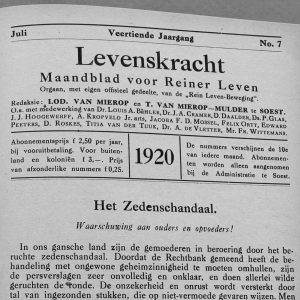
July — Truus van Mierop, co-founder of the Pure Life Movement, a society that is committed to women’s emancipation and a chaste lifestyle, reports on Yazdání’s presence at the outdoor meeting in Overveen, in the monthly magazine Levenskracht.

While Ibn-i-Asdaq stays in The Hague, Yazdání travels by train to various towns and villages to give his speeches.
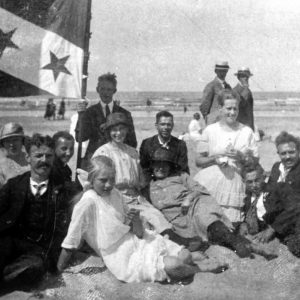
Early July, samideano (soul mate) Yazdání is invited by the Esperanto club of the flower town Aalsmeer.
“In another city [Haarlem?] they had brought a priest with some of his followers for a conversation with me. He arrogantly and smugly denied that a new revelation was needed and said that the revelation of Christ was sufficient for the salvation of mankind. I replied that Christ had said that the Leader of the world will come, but he immediately denied that such prophecies are in the Bible. [...] I then turned my full attention to the Abhá Kingdom, and grabbed the Bible to look for that verse. At that moment I received the divine blessings; as soon as I had opened the Bible, the page showed John 16, the verse I had quoted. This caused amazement to those present and the priest was so embarrassed that he did not continue the conversation and left.”
— Ahmad Yazdání, recollections
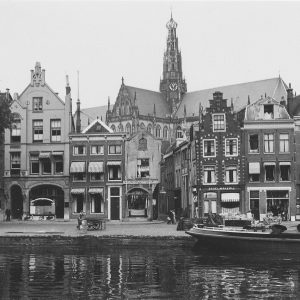
During a visit to Haarlem in early July, Yazdání has to deal with a critical Catholic audience.
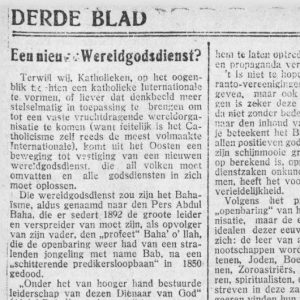
In the week of Monday July 12, Yazdání is interviewed at his hotel by Jan van der Lans, the retired editor-in-chief of the national Catholic newspaper De Tijd. The article is published in the Saturday edition of July 17.

July 18 — This Sunday Yazdání travels to Zaandam to give a talk at the new Theosophical center at the Westzijde (film). His Esperanto interpreter that day, Frits Faulhaber, publishes the lecture in full in the local Theosophical magazine Spiritual Life (Geestelijk Leven).
“We salute you, dear audience, and thank you for coming to learn the principles of Bahaism. To study Bahaism, it must be dealt with in three parts: its history, its principles, and its evidence. […]
I advise you to work for divine love, because you have kept the peace, the progress in your country. In the world there are now many wrongs. In most countries war is raging or its aftermath is felt. You Dutch are still healthy. You are spared the misery and afflictions the other nations are suffering from. Go and heal the sick. — If there are any among you who still have questions for me, you can do so by letter. I will answer them all. […]”
— Ahmad Yazdání, Zaandam 18 July 1920
Second Tablet to The Hague

1920 August 2-6 — ‘Abdu’l-Bahá’s answer to the letter of the Executive Committee arrives this week and is also delivered to the secretary’s office by Yazdání and Ibn-i-Asdaq. It is their last contact with the Central Organization for a Durable Peace. Both tablets to The Hague are now made public in the American Bahá’í Magazine Star of the West. (1920 August 1 and 1921 January 19)
“Our desire for peace is not derived merely from the intellect: It is a matter of religious belief and one of the eternal foundations of the Faith of God. […]
Today the benefits of universal peace are recognized amongst the people, and likewise the harmful effects of war are clear and manifest to all. But in this matter, knowledge alone is far from sufficient: A power of implementation is needed to establish it throughout the world. Ye should therefore consider how the compelling power of conscience can be awakened, so that this lofty ideal may be translated from the realm of thought into that of reality. […]
It is our firm belief that the power of implementation in this great endeavour is the penetrating influence of the Word of God and the confirmations of the Holy Spirit. […]”
— ‘Abdu’l-Bahá to the Executive Committee, letter July 1920
Last public appearance
1920 August — Hundreds of Esperantists from all over the world converge on The Hague for their annual world meeting, the 12th Universal Esperanto Congress (12a Universala Kongreso de Esperanto Hago).
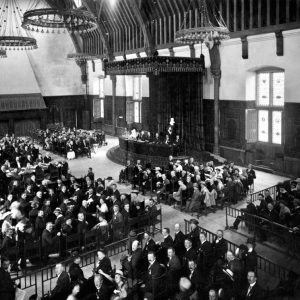
August 8 — On Sunday afternoon Yazdání and Ibn-i-Asdaq attend the opening session of the congress in the Ridderzaal at the Binnenhof. They are the only Persians. Jan Isbrücker is chairman.
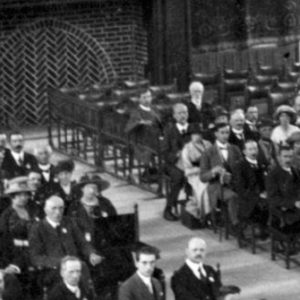
‘Alí-Muhammad Ibn-i-Asdaq with white turban is sitting in the back row next to the Esperantist Jacob Bruijn.
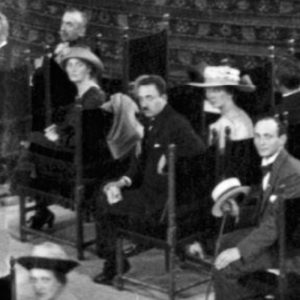
Julia Isbrücker is wearing a hat with a folded brim. Ahmad Yazdání sits right behind her.
“The numerous strangers in our city, equipped with the sign of the Esperantists, a flag with a green star, already clearly showed that The Hague is this week dominated by Esperantism. Already Saturday the numerous congress visitors from France, England, Germany, Denmark, Sweden, Norway, Italy, Spain, Austria, Hungary, and even from Russia and Persia were at the Girls H.B.S. [Highschool] on the Bleyenburg, where all were registered. It was a ‘va et vient’ [coming and going] of various strangers. Here the efficiency and usefulness of Esperanto was already demonstrated.”
— Het Vaderland, 9 August 1920
Mission completed
1920 August 9 — After a stay of almost three months in The Hague, the two envoys leave the Netherlands on a train bound for Paris on a cloudy but dry Monday morning. The project they had started five years ago is completed. They had personally delivered ‘Abdu’l-Bahá’s Tablet of Peace, and became the first Persian believers to introduce the Bahá’í Faith to the Netherlands. (photos: Hollandsch Spoor railway station in The Hague and the railway viaduct through the center of Rotterdam)
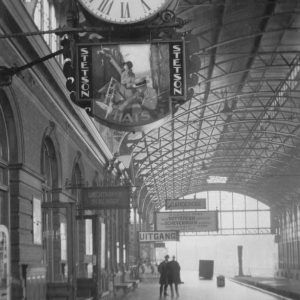
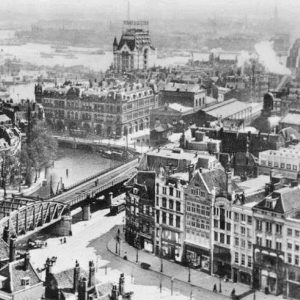

epilogue
“You must have high esteem for Mírzá Ahmad Khan Yazdání, for it was he who brought you this Great Tidings.”
— ‘Abdu’l-Bahá to Julia Isbrücker, letter 15 October 1920

Ahmad Yazdání (1891-1977) became editor-in-chief of the Bahá’í News of Iran and served as a member of the National Spiritual Assembly of Iran for many years.
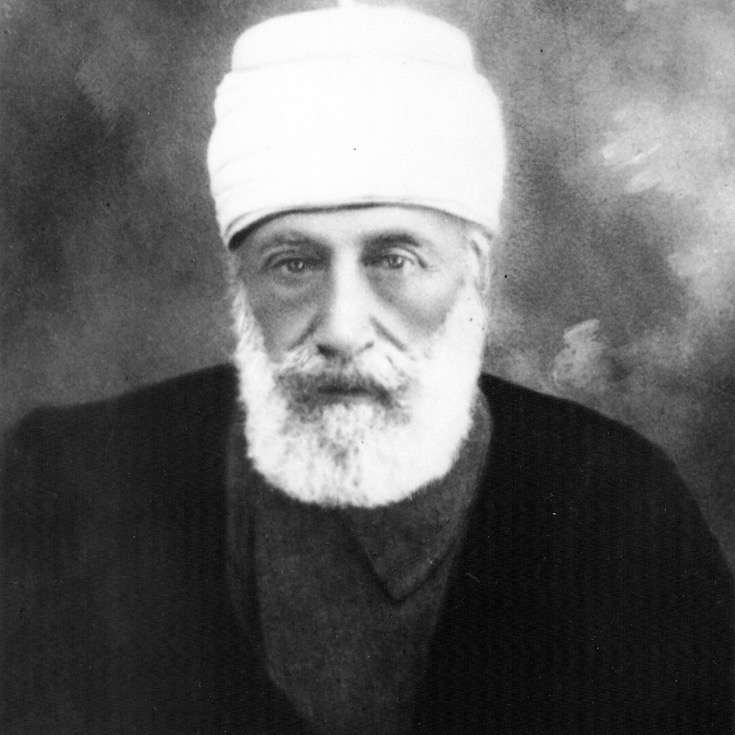
‘Alí-Muhammad Ibn-i-Asdaq (c.1850 -1928) remained in Haifa until the spring of 1921. He then returned to Persia. His journey to the Netherlands was his last major journey in the service of the Cause of God.

Julia Isbrücker (1887-1971) gave lectures on ‘Bahaism’ and in 1928 organized the international ‘Peace by Religion’ conference in The Hague. She became friends with prominent Bahá’í Esperantists such as Martha Root and Lidia Zamenhof.

Henri Dresselhuys (1870-1926) continued to work as a Member of Parliament and for the League of Nations. To honor his work a memorial stone was placed behind the Peace Palace.

Henri van der Mandere (1883-1959) was for many years director-secretary of the Open University of The Hague. He published extensively about the Peace Movement, the League of Nations and the United Nations.
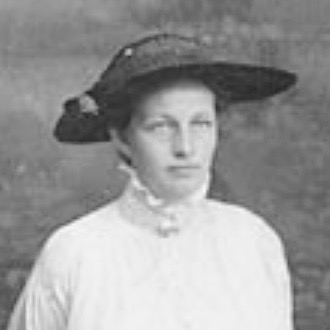
Clasien Kluyver (1884-1974) became a member of the Dutch delegation to the League of Nations. Her residence, the secretariat of the Central Organization, was destroyed in an air raid in 1945. Kluyver became head of the UN department of the Ministry of Foreign Affairs.
***
